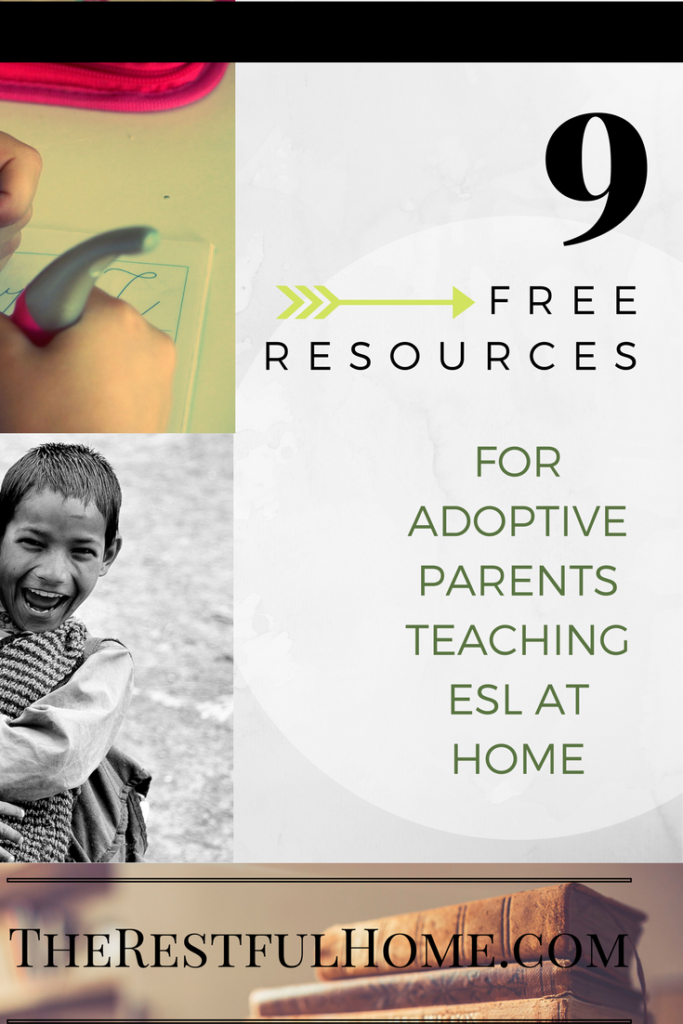
She sounded desperate when I met her that Sunday after church. “You’re an ESL teacher?” I looked up, surprised this strange woman knew anything about me, and nodded. “Your fiancé told me,” she explained (yes, this was pre-marriage). “Can you tell me what to do? I have no idea how to teach my kids English.” I never saw her again, but this list of 9 free resources for adoptive parents who need to teach their children ESL is for her, and for other parents in her situation.
Many parents feel as though they speak a different language from their kids, but for thousands of parents who have adopted internationally, this language barrier is a reality. In 2015 alone, the U.S. Department of State reported 5,647 international adoptions. Over 1800 of those adoptions were of children aged 5-12 years old (school-aged, and probably able to speak their native language fluently). Nearly 800 were of children over the age of 12. The numbers of adopted school-aged children in 2013 and 2014 were even higher.
Granted, some of these children speak English, particularly those from former British colonies in Africa. However, many of them must begin at Ground Zero.
The mother pleading for my help had just adopted three children from the Ukraine. One, a beautiful and clearly intelligent teenager, spoke a little English she had learned in school. Her younger siblings could speak only a few words in English. Mom was trying to homeschool them along with her two biological children, who of course could speak English very well and knew only a few words in Ukrainian or Russian.
In this situation, is it time to put the kids in a public school and rely on the expertise of trained ESL (English as a Second Language) teachers? Maybe there are cases when this has to happen; however, many dedicated homeschoolers would by far rather help their children adjust to a new country and a new language themselves. So how can they do that at home?
Here are 9 free resources for adoptive parents that I have used in teaching and tutoring or that I would recommend to my own students who wanted to keep working at home.


Don’t neglect to check the resources of your library. Larger cities will most likely have books and DVDs for helping second language learners. Smaller towns will have children’s books that are some of the greatest tools for learning a new language. I have read books geared toward toddlers to a roomful of enthralled adults who were excited to finally understand a book in English. Read aloud and let them try to read.
When I lived in Houston, I also had access to an amazing free language-learning program called Mango Languages. I highly recommend it for older children. The only downside of Mango Languages is that the learner has to choose a native language, which is fine if your child speaks a major language like Arabic, Spanish, or French, but doesn’t work as well if he or she speaks Burmese or Tigrinya (an Ethiopian and Eritrean language). Ask your librarian what resources are available.
2) Randall’s ESL Cyber Listening Lab.
This site is excellent for practicing listening to English. Conversations are at normal speed and include questions to check comprehension. They are divided into Easy, Medium, and Difficult categories. However, I would recommend this site more for teenagers who are intermediate speakers than for beginners, since most of the conversations are fairly rapid.
3) ESLvideo.com.
My students and I both loved this website. It contains videos appropriate for a wide variety of ages, from kindergarten to adult (although at the higher levels, when movie previews are included among the videos, you will probably want to watch the videos before your child does to make sure you approve of the content). The videos are organized in five categories, from beginning to advanced. Comprehension questions are also included with each video.
4) YouTube.
Yes, YouTube has great ESL resources along with its overabundance of makeup tutorials and fake shark-swallowing-girl videos. When I was teaching 1st-3rd graders, I used songs from YouTube to help them learn new words. Examples: “Seasons Song,” by Pancake Manor; “Itsy Bitsy Spider,” performed by KidsCamp (which has many other good learning songs for numbers and other nursery rhymes); “Five Little Monkeys”—the kids loved this bluesy version!—by the Learning Station.
5) PBS Kids website.
I am not a fan of having kids spending a lot of time playing games at a computer, but some of the games on PBS kids are excellent for learning how to follow simple instructions. This website might be something you want to use as a reward for your child aged 6-12 that will keep him learning while he plays.
6) Talk to your child!
Even if it seems the child isn’t responsive, it’s completely normal for a second language learner to go through what is called a silent period as he/she adjusts to hearing a new language. Your child understands more than you might think, and will eventually begin responding appropriately. Don’t push a shy child to speak when he/she has only been in the country for a few months. Language production will eventually happen.
7) Provide opportunities for your child to play/interact with other children.
If you already have children in your home who speak English, you don’t have to worry about this as much. But if not, I believe it’s important to ensure that your children learn from other children. They may become more motivated to learn English more quickly because they want to be able to communicate effectively with their peers.
8) Play games.
Make phrasal, or two-part, verbs into dominoes (yes, you can find a template online). (An example of a phrasal verb would be “run into,” or “hang up”—but don’t get overwhelmed by the grammatical terms!) Play Go Fish with animal cards, or food cards, or whatever else you can think of to use. I printed and laminated my own cards for young children. Once they learned how to play the game, they easily added new vocabulary words. “Do you have a cow?” they would ask eagerly—and woe to the child who denied having a cow in his hand when other children knew for certain it was there! Play Spot It with the whole family—children will have incentive to learn the vocabulary when they have to spot the correct item on the round cards in their hands.
9) Encourage use of their native language.
Literacy in one language has been shown to increase literacy in a second language. Of course, this concept doesn’t help if your child was raised in multiple refugee camps without schooling before she came to you. But for many school-aged children, it is a great idea to encourage them to continue to speak, listen to, and read books in their native language.
